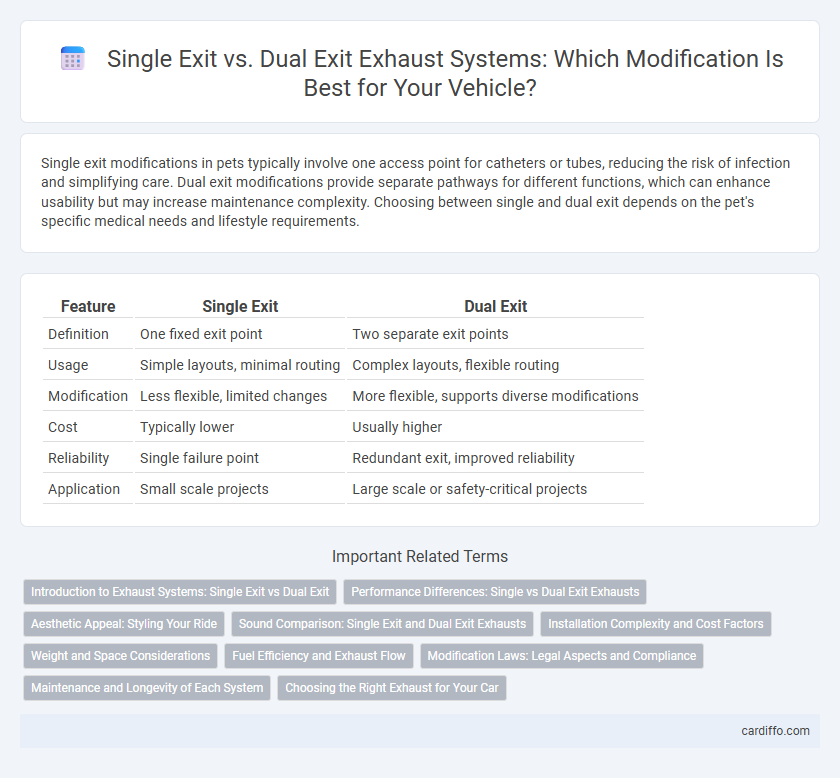Single exit modifications in pets typically involve one access point for catheters or tubes, reducing the risk of infection and simplifying care. Dual exit modifications provide separate pathways for different functions, which can enhance usability but may increase maintenance complexity. Choosing between single and dual exit depends on the pet's specific medical needs and lifestyle requirements.
Table of Comparison
| Feature | Single Exit | Dual Exit |
|---|---|---|
| Definition | One fixed exit point | Two separate exit points |
| Usage | Simple layouts, minimal routing | Complex layouts, flexible routing |
| Modification | Less flexible, limited changes | More flexible, supports diverse modifications |
| Cost | Typically lower | Usually higher |
| Reliability | Single failure point | Redundant exit, improved reliability |
| Application | Small scale projects | Large scale or safety-critical projects |
Introduction to Exhaust Systems: Single Exit vs Dual Exit
Single exit exhaust systems feature a single tailpipe that channels exhaust gases from the engine, offering a simpler design and reduced weight. Dual exit exhaust systems split the exhaust flow into two separate tailpipes, enhancing exhaust gas evacuation and potentially improving engine performance and sound quality. Selecting between single and dual exit configurations depends on factors such as vehicle type, desired exhaust flow characteristics, and performance goals.
Performance Differences: Single vs Dual Exit Exhausts
Single exit exhaust systems typically offer reduced backpressure, enhancing engine performance and providing a more aggressive exhaust note, which can improve acceleration and horsepower. Dual exit exhausts distribute exhaust gases through two outlets, potentially improving exhaust flow at higher RPMs and offering better balance for V8 or larger engines. Performance differences hinge on vehicle type and tuning, with single exits favoring compact setups and dual exits benefiting high-performance or naturally aspirated engines seeking optimal exhaust scavenging.
Aesthetic Appeal: Styling Your Ride
Single exit exhaust systems create a clean, streamlined look that enhances the rear profile's simplicity and sophistication. Dual exit exhausts offer a balanced, aggressive stance that complements performance vehicles with symmetrical tailpipe finishes. Choosing between single or dual exits impacts the overall aesthetic appeal and can personalize the vehicle's exterior image to match individual style preferences.
Sound Comparison: Single Exit and Dual Exit Exhausts
Single exit exhausts typically produce a deeper, more focused sound due to the singular exhaust outlet concentrating the exhaust flow, enhancing low-frequency tones. Dual exit exhausts generate a louder and more aggressive sound profile by allowing exhaust gases to exit through two outlets, which promotes better gas dispersion and higher frequency resonance. Sound comparison reveals that single exit systems favor a rumbling, throaty exhaust note while dual exit setups emphasize a sharper, more performance-oriented acoustic character.
Installation Complexity and Cost Factors
Single exit installations typically involve fewer components and simpler wiring, resulting in reduced labor costs and shorter installation times. Dual exit systems require additional equipment and more complex routing, increasing both material expenses and the potential for installation errors. Cost factors favor single exit setups for straightforward projects, while dual exit configurations are justified in scenarios demanding redundancy and enhanced reliability.
Weight and Space Considerations
Single exit designs reduce overall weight, making them ideal for applications where minimizing mass is critical. Dual exit configurations, while slightly heavier due to additional components, optimize spatial distribution by allowing multiple connection points and flexible installation. Choosing between single and dual exit depends heavily on balancing weight constraints with available space and required accessibility.
Fuel Efficiency and Exhaust Flow
Dual Exit exhaust systems typically enhance fuel efficiency by reducing backpressure and improving exhaust flow dynamics compared to Single Exit designs. Enhanced exhaust flow in Dual Exit configurations allows for quicker expulsion of combustion gases, optimizing engine breathing and power delivery. Single Exit systems may restrict exhaust flow, potentially increasing fuel consumption due to less efficient scavenging of exhaust gases.
Modification Laws: Legal Aspects and Compliance
Modification laws governing Single Exit and Dual Exit schemes impose strict compliance requirements to ensure transactional transparency and regulatory adherence. Legal frameworks mandate clear documentation and justification for modifications, including specific approvals to prevent disputes and maintain fair trading practices. Adhering to these compliance standards mitigates risks associated with contractual amendments and enhances enforcement under commercial law.
Maintenance and Longevity of Each System
Single exit systems generally offer easier maintenance due to fewer components and simpler access points, reducing the risk of failure and minimizing repair costs over time. Dual exit systems, while more complex, provide redundancy that can enhance system longevity by allowing one exit to remain operational during maintenance or repairs. Proper upkeep tailored to each system's design significantly influences durability, with dual exits often requiring more frequent inspections but potentially delivering extended service life under continuous use.
Choosing the Right Exhaust for Your Car
Choosing the right exhaust system hinges on your car's performance goals and engine type; single exit exhausts offer a straightforward design that enhances low-end torque and fuel efficiency, ideal for daily driving. Dual exit exhausts improve exhaust flow and increase horsepower by reducing back pressure, making them preferable for high-performance vehicles and those seeking aggressive sound profiles. Evaluating factors like engine displacement, desired sound level, and weight impact ensures the optimal balance between power, aesthetics, and efficiency.
Single Exit vs Dual Exit Infographic

 cardiffo.com
cardiffo.com